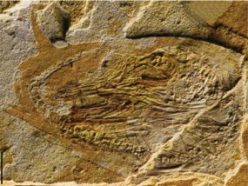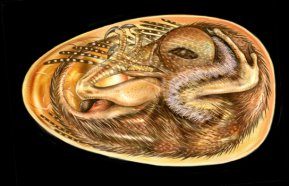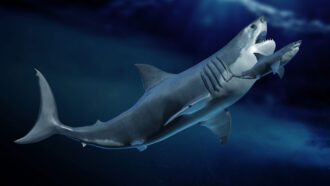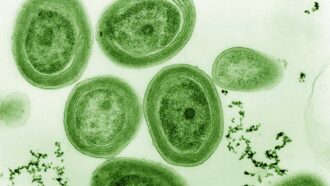Early birds ready to rumble
A fossil hints that prehistoric baby birds could have fed themselves soon after hatching.
Who needs parents? Not some prehistoric baby birds!
Baby birds living in the age of dinosaurs might not have been as helpless as are songbird nestlings today, who constantly call out for their parents. Instead, some of these ancient youngsters were born with strong bones and well-developed feathers, according to a team of Chinese scientists.
 |
|
The bones and other features of a fossil embryo suggest that birds of this prehistoric species could move about and feed independently soon after hatching.
|
| © Science |
The Chinese paleontologists found a 121-million-year-old fossil of a bird that was curled up tightly. The bird’s feet were tucked under its beak, and it had a wing resting behind its head.
The bird’s bones were squished up in an egg-shaped space. And the baby appeared frozen in the same position that a modern-day chick would find itself just before it cracked open its shell. The scientists concluded that their specimen was a bird embryo, fossilized before it could hatch.
 |
|
In this illustration based on a fossil, an artist shows a prehistoric baby bird’s position and features just before hatching.
|
| Courtesy of Zongda Zhang. |
The researchers couldn’t tell the bird’s species. But the baby bird did have some unusual features. Its feathers were almost fully formed. Its bones were hard and relatively strong. It had a large skull.
These traits suggest that the bird could have moved around and caught its own food soon after it popped out of its egg, the scientists say.
Nowadays, many types of baby birds stay in the nest for at least a couple of days and are completely dependent on their parents for food and protection. They’re often covered by soft, fuzzy down, which makes them very cute but doesn’t do much for their flying abilities.
Fossils of 75-million-year-old bird embryos that were found previously didn’t show signs of well-formed feathers either. The Chinese researchers say that, as birds evolved, chicks became more dependent on their parents. But it’s also possible that the later fossils were of embryos before they had had time to develop feathers. Or the feathers simply weren’t preserved.
Still, the fossil found in China hints that baby birds have changed a lot in the last 120 million years. Being able to fend for itself right after hatching would make that prehistoric bird one tough chick.







